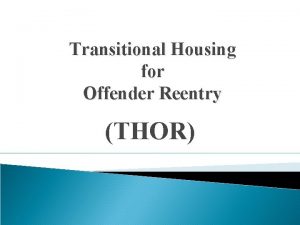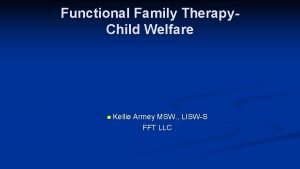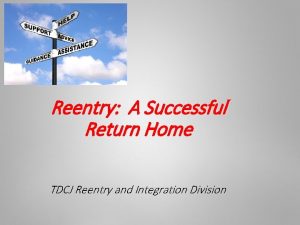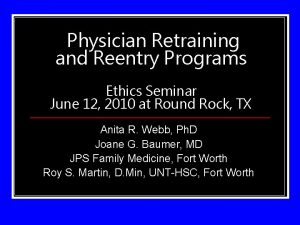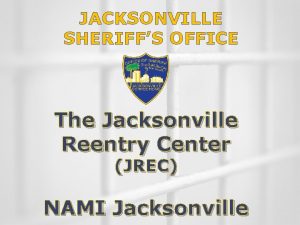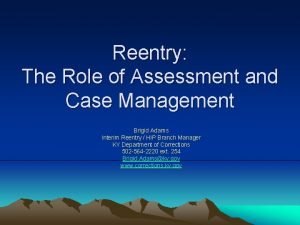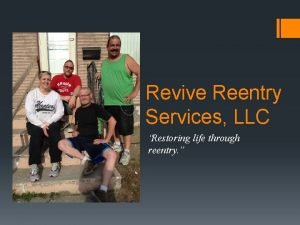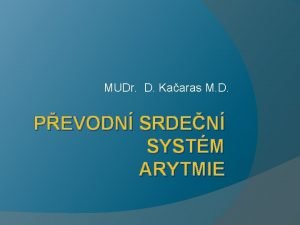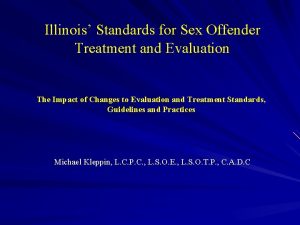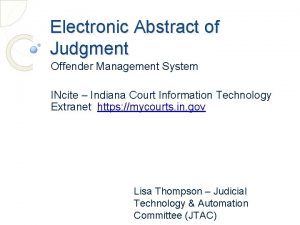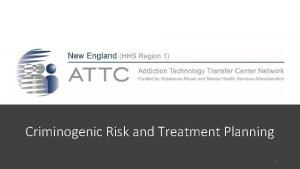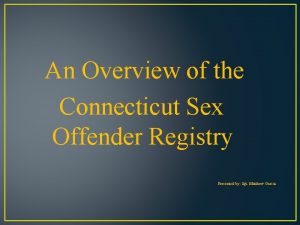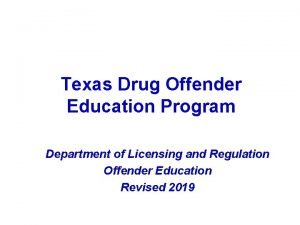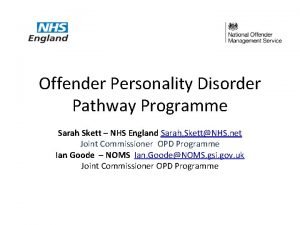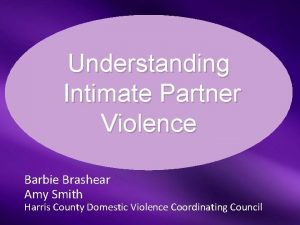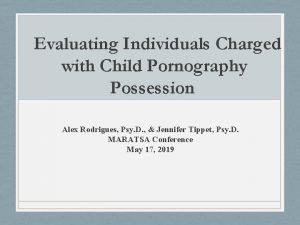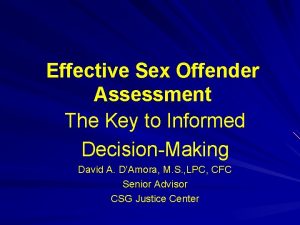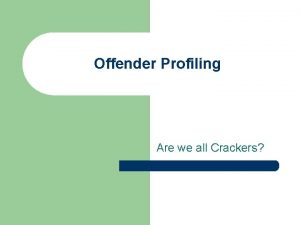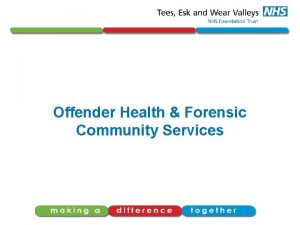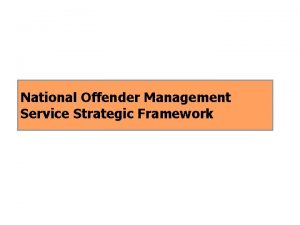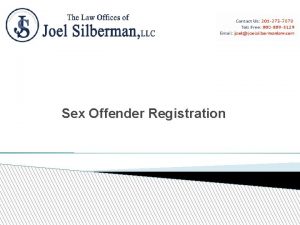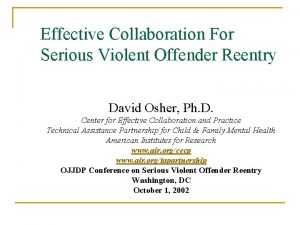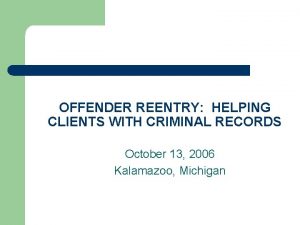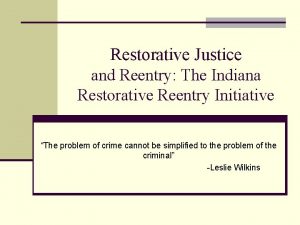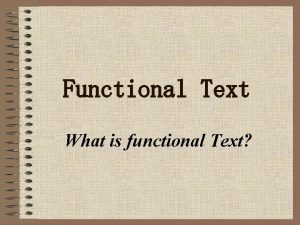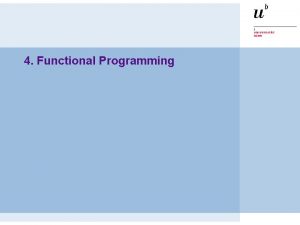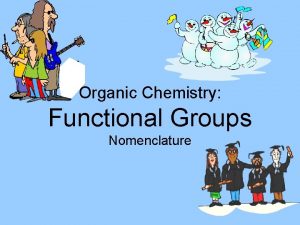New Initiatives Supporting Offender Reentry Functional Family Therapy

































- Slides: 33

New Initiatives Supporting Offender Reentry: Functional Family Therapy for Adults Corinne Datchi-Phillips, Ph. D. Center for Adolescent & Family Studies Indiana University-Bloomington Christine Mc. Afee Juvenile Division Supervisor Monroe County Community Corrections

Outline • Introduction (Corinne) – – – Indiana Family Project Functional Family Therapy The “Adult FFT Project” • Social control theory • Functional Family Therapy for adult offenders (Corinne) – Core principles of the model • A multisystemic view of the client and the problem • Systematic goals – Risk and protective factors • Risk factors of adult offending • Risk factors specific to women offenders – Preliminary results

Outline • Implementation of a family-focused intervention: The perspective of community corrections (Chris) – Challenges of the Indiana Family Project • • For the juvenile division For the adult division – Becoming a family-focused organization • • Rationale Steps to consider

The “Adult FFT Project” Introduction

Introduction • The Indiana Family Project – Partnership with Monroe County Circuit Court and Community Corrections since 2001 – Functional Family Therapy (FFT) Services for atrisk youth and their families • Since 2001, 267 youth have received services at no cost. • FFT is an evidence-based intervention for adolescents with behavioral problems, implemented in diverse settings internationally. • Working with youth and parental figures to address the risk factors that associated with youth’s behavioral problems.

Introduction • The Indiana Family Project – An effective program that contributes to reduce youth’s level of difficulties • 5. 8% program dropout rate for the year 2009 -2010 (compared to 40 -60% for traditional programs) • Reduction in youth’s emotional and behavioral problems from the perspective of both the youth and the parents’ perspective.

Introduction • The Indiana Family Project – Since January 2010, FFT services extended to adult offenders and their social support system (e. g. , partners, parents, relatives that are involved in the life of the adult) • Evaluation in progress – Why family-focused services for adult offenders? • As individuals age, their pattern of deviance and offending change. – Adult behaviors are influenced not only by childhood experiences and individual levels of self-control, but also by major life events that occur in adulthood. • Major life events in adulthood (e. g. , marriage, parenting) have the potential to influence adult desistance from criminal activity. – For example, marital support in early adult life functions as a protective factor (Sampson & Laub, 1993).

Introduction • The Indiana Family Project – Why family-focused services for adult offenders? • Informal Social Control Theory (Sampson & Laub, 1993) – Key principle of social control theory: » Criminal behavior is function of the strength of an individual’s bond to society. The weaker the bond, the greater the likelihood of criminal activity. » Social control is a social group’s ability “to regulate itself according to desired principles and values” (p. 18). Social groups regulate themselves through institutions such work, family, and school that structure the interpersonal bonds between members of the group. – Key institutions of informal and formal social control: » In childhood & adolescence: family, school, peer group, juvenile justice system • Sources of informal social control in the family: Consistent use of discipline, monitoring, attachment » In young adulthood: Institutions of higher education, work, marriage, adult criminal justice system » In middle adulthood: work, marriage, parenthood, investment in the community, criminal justice system

Introduction • The Indiana Family Project – Why family-focused services for adult offenders? • Marital and familial relationships in adulthood: two core assumptions – Pathways to crime in adulthood are mediated by individuals’ social bonds to the institution of marriage and the family. – Social bonds, when strengthened, have the capacity to reduce adult offenders’ criminal behaviors. » Changes in the quality and strength of adults’ social bonds within the institution of marriage and the family will lead to less crime and deviance. • Strong attachment to a spouse, close emotional ties » “Interdependent social bonds increase social capital and investment in social relations and institutions” (Sampson & Laub, 1993, p. 21) • Within-family alliance, sense of relatedness and working together … individual investment in the relationship

Introduction • The Indiana Family Project – Why family-focused services for adult offenders? • Adult offenders go to their family for assistance with reentry issues. • Family involvement in offenders’ rehabilitation is associated with better prognosis and lower rates of recidivism (Council of State Government, 2005; Sullivan, Mino, Nelson, & Pope, 2002) YET few intervention programs specifically target familial issues that constitute major risk factors in the social rehabilitation of adult offenders.

The “Adult FFT Project” Innovative family-focused strategy to reduce adult recidivism

The “Adult FFT Project” • Functional Family Therapy – An effective evidence-based family-focused program originally designed to target youth involved in the criminal justice system • Over 30 years of research showing that FFT is effective in reducing recidivism • Short-term intervention • Intervenes in the ecological system in which individuals and their problems are embedded (family, community) – FFT is a systematic clinical intervention program • With core principles that guide therapists’ understanding of the client, the problem, and therapeutic change • with systematic goals for each phase of treatment – Phase I: Engage & Motivate – Phase II: Change family processes (interactions) in which the problem is embedded by building behavioral skills – Phase III: Generalize change to multiple areas of the individual and family’s life

The “Adult FFT Project” • Retains the core principles of FFT (systemic view of the problem, systematic goals, therapeutic processes) – Focuses on the family system adult offenders go to for assistance • Traditional, extended or elected families (offenders’ closest emotional connections) – with the goal of changing maladaptive interactions that weaken the individual social tie to the family and therefore a risk factor for recidivism • Change the balance between risk and protective factors, that is, reduce risk factors and increase/strengthen protective factors within the family system • Attend to the multiple needs of the individual in the context of the local community, and address risks specific to the individual … 3 components of effective treatment (National Institute on Drug Abuse, 2006)

The “Adult FFT Project” • Why do FFT with adult offenders? – FFT is an ideal program • Evidence-based with an established record of success • Goals consistent with the Principles of Effective Intervention – Engagement/motivation » Target intrinsic motivation – Risk factors associated with criminal activity and drug use & Within-family protective factors and the prevention of recidivism » Need principle » Skill training » Engage community support • “Match to” principle of FFT: Taking into consideration the uniqueness of each family & respect for differences – Responsivity principle

FFT Core Principles • From the perspective of FFT – The client is part of a relational system which itself is part of a community, culture, society (ecological model) – The problem behaviors are embedded in the relational patterns of this system.

Cultural/Ethnic/Racial “Context” Spouse Adult Children Community Family The family-first principle

The Problem • Symptoms Anger/aggression Drug/alcohol abuse Mental health Associated with Risk and Protective Factors In the individual In the family In the social/environmental context Maintained by family relational patterns Target of Change Familial patterns that promote adult risk or protective behaviors

The “Adult FFT Project” • Adult offenders’ criminogenic risks and needs: What we know – Social/Relational factors: • Associates – form a social context that provides models for imitation and is characterized by a set of beliefs & values • Low levels of family cohesiveness – Individual traits: • Lack of self-control, social maladjustment, alienation, aggression, withdrawal, social anxiety, Asocial tendencies, immaturity, tendency to distort reality

The “Adult FFT Project” • Risk factors and pathways to crime: – Substance abuse and criminal activity • Drug and alcohol addiction among adult offenders is 4 times higher than among non-correctional populations. • Up to 50% of male adult offenders and 42% of female adult offenders are at risk for drug and alcohol dependence (National Institute of Justice, 2003). • Factors such as difficulty in employment, antisocial peer association, and family conflict correlate highly with the development of drug and alcohol addiction.

The “Adult FFT Project” • Risk factors and pathways to crime – Substance abuse and familial relationships • Families can serve as a protective factor, a support system that the offender can turn to for assistance with housing, employment, and health-related needs. • Families can also be a major stressor that increases the likelihood of relapse to substance use post-incarceration (Chandler, Fletcher, & Volkow, 2009).

The “Adult FFT Project” • Risk factors and pathways to crime – Substance abuse, criminal activity, and familial relationships • Strained marital interactions are related to increases in substance use and relapse (Birchler, Fals-Stewart, O’Farrell, 2005). • Relationship distress is associated with poor outcomes for clients with alcohol and drug problems (Birchler, Fals-Stewart, O’Farrell, 2005).

The “Adult FFT Project” • Risk factors specific to women & girls – Mental health (e. g. , depression, PTSD, self-mutilation) – Self-esteem – Parental stress • 70% of women probationers are the primary caretakers of young children. – Relationship dysfunction • Relationships with family members, partners, friends that lead to criminal involvement (e. g. , supporting partner’s drug addiction through prostitution) – Substance use • The relation between women’s substance use and criminality is very strong. – 80% of women in prison have substance-related problems. – 1 in 3 women in state prison engaged in criminal activities to support their drug use.

The “Adult FFT Project” • Goals and desired outcomes of the program – Increase family cohesiveness: • The adult offender and his family are working together to solve the problems of daily living – Decreased relationship distress and conflict • The family supports offenders’ efforts to seek and maintain employment, to go back to school, etc. – “Social maladjustment/alienation” risk • The family provides the offender with a new avenue for prosocial leisure activities and prosocial relationships – “Associates” risk • The family supports adult offenders’ use of new, prosocial behavioral skills (e. g. , problem solving, effective communication strategies, conflict management) – “Social anxiety” risk

The “Adult FFT Project” • Preliminary Results – Number of referrals: 43 – Number of clients who did not start: 9 • • Unable to contact: 1 Referred to individual therapy: 3 Probation violation: 2 Other: 3 (no family system; family system declined services) – Number of early termination: 4 • • Court order of no contact: 1 Probation ended: 1 Declined services: 1 Moved prior to termination: 1 – Number of adults still active: 21 – Number of completers: 9

The “Adult FFT Project” • Preliminary Results – Completers profile • Mean age = 34 [19 -46] • Sex: – 58. 3 % male – 41. 7 % female • Relationship status: – 8. 3% single – 58. 3 % married – 33. 3% in domestic partnership • Race: – 75% White; – 25% Black or African American

The “Adult FFT Project” • Preliminary Results – Completers profile • Education: – 33. 3% high school no diploma; 41. 7 % high school graduate or GED; 8. 3% Associate’s degree; 16. 7% Graduate or professional degree • Employment: – 16. 7% unemployed – 75% employed – 8. 3% not in the labor force

The “Adult FFT Project” • Preliminary Results – Completers’ level of family cohesiveness (N = 6) • From offenders’ perspective, family cohesion increases 9. 11 points on average. – Improved social tie to the family and/or marital system • From family members’ perspective, family cohesion increases 2. 16 points on average. – Slight increase – It is possible that family members experienced higher investment in the relational ties, hence their involvement in therapy.

The “Adult FFT Project” • Preliminary Results – Completers’ level of family conflict • From offenders’ perspective, family conflict decreases 8. 22 points on average (n = 9) – Supports the idea that family cohesiveness increases; greater ability to resolve problems within the family • From the family’s perspective, family conflict decreases 7 points on average (n = 6)

Implementation of a family-focused intervention: The perspective of community corrections Chris Mc. Afee

The Perspective of Community Corrections • The Indiana Family Project – Challenges • • For the juvenile division For the adult division – Becoming a family-focused organization • • Rationale Steps to consider & recommendations

The “Adult FFT Project” Comments or Questions

References Council of State Governments. Reentry Policy Council. (2005). Report of the Re. Entry Policy Council: Charting the safe and successful return of prisoners to the community. New York: Council of State Governments. Available at: http: //reentry. microportals. net/report/T OC National Institute on Drug Abuse. (2006). Principles of drug abuse treatment for criminal justice populations.

References Sampson, R. J. , & Laub, J. H. (1993). Crime in the making: Pathways & Turning Points Through life. Cambridge, MA: Harvard University Press. Sexton, T. L. & Alexander, J. F. (2005). Functional Family Therapy for externalizing disorders in Adolescents. In J. L. Lebow (Ed. ), Handbook of Clinical Family Therapy (pp. 164 -191). Hoboken, NJ: John Wiley & Sons.
 Thor housing georgia
Thor housing georgia Once a sex offender always a sex offender
Once a sex offender always a sex offender Functional family therapy nyc
Functional family therapy nyc Limitations of functional family therapy
Limitations of functional family therapy Suspension therapy is a type of exercise
Suspension therapy is a type of exercise Tdcj reentry program
Tdcj reentry program Physician reentry program
Physician reentry program Jacksonville reentry center
Jacksonville reentry center Reentry case management
Reentry case management Reentry partnership housing
Reentry partnership housing Grizzly energy, llc
Grizzly energy, llc Idioventrikulární rytmus
Idioventrikulární rytmus Psychoanalytic vs humanistic
Psychoanalytic vs humanistic Bioness bits cost
Bioness bits cost Humanistic therapy aims to
Humanistic therapy aims to Latihan fungsional
Latihan fungsional Semi fixed space maintainer
Semi fixed space maintainer Non functional plasma enzyme example
Non functional plasma enzyme example Enzymes of blood plasma
Enzymes of blood plasma Functional and non functional
Functional and non functional Prashant chopra sex offender
Prashant chopra sex offender Sex offender evaluation illinois
Sex offender evaluation illinois Indiana incite
Indiana incite What are the 8 criminogenic needs
What are the 8 criminogenic needs Offender workforce development specialist
Offender workforce development specialist Megan kanka
Megan kanka Texas drug offender education program test answers
Texas drug offender education program test answers Offender personality disorder pathway
Offender personality disorder pathway A tyrannical offender:
A tyrannical offender: Yakama nation license plate
Yakama nation license plate Top down approach to offender profiling
Top down approach to offender profiling Interview with sex offender
Interview with sex offender [email protected]
[email protected] Minnesota sex offender screening tool
Minnesota sex offender screening tool
